I actually finished a garment. OK, it's a hat. Not so big. Such is my attention span.
I'm making another one now. This one is a tad small, but I ran out of yarn. I decided to use red to finish it off, and I think it looks kind of neat. It's a feature, not a bug!
This hat is created from entrelac squares that are done in ribbing. I used 3 by 3 ribbing because it's quite stretchy and I didn't want to swatch or anything. I figured with the stretchiness the hat would fit my head no matter what.
I'm writing up a pattern for it. More pictures of this on my Flickr account, and more info at my Ravelry page (user name "yarnover").
Wednesday, December 30, 2009
Thursday, December 17, 2009
Mosaic Knitting Alphabet
I think I posted about this before, but here is a font I created on the FontStruct website called Mosaic4way. It’s a font you can use to create writing in mosaic knitting. I call it Mosaic4Way because you can knit from the alphabet in any direction. Three of the directions (top, bottom, left) are depicted below.
Click on the picture below (or the following link) to be taken to the page where the font is hosted on Fonstruct. You can download it for free and use it freely for non-commercial purposes. You should give me credit if you share any patterns that use it, and ask permission if you want to use it for commercial purposes.
If you need help to install your new font, follow this link to FontShop's font installation instructions.
Here's a screen shot of all the characters in the font (click to get bigger sizes). I can't remember, but I think I did all the Western European letters, so there is plenty of accented goodness, but Eastern European alphabets users are likely out of luck. Hey, but there is a Euro symbol!

Here's some knitting done with the font:
Click on the picture below (or the following link) to be taken to the page where the font is hosted on Fonstruct. You can download it for free and use it freely for non-commercial purposes. You should give me credit if you share any patterns that use it, and ask permission if you want to use it for commercial purposes.
If you need help to install your new font, follow this link to FontShop's font installation instructions.
Here's a screen shot of all the characters in the font (click to get bigger sizes). I can't remember, but I think I did all the Western European letters, so there is plenty of accented goodness, but Eastern European alphabets users are likely out of luck. Hey, but there is a Euro symbol!

Here's some knitting done with the font:
Labels:
alphabet,
Crafts,
Fonts,
FontShop,
FontStruct,
knitting,
Mosaic Knitting,
Non-commercial,
Typeface
Wednesday, December 16, 2009
Illustrating lace knitting
 I posted recently some diagrams I made of Barbara Walker's "Day-flower" lace insertion pattern found in one of her Treasuries stitch collection books.
I posted recently some diagrams I made of Barbara Walker's "Day-flower" lace insertion pattern found in one of her Treasuries stitch collection books.It took a lot of practice and exploration for me to be able to do that latest, most detailed diagram.
About two years ago I was trying to figure out how to illustrate knitting stitch patterns in the old-school way, where it's all hand-drawn, showing each twist and turn of the knitted yarn. I did develop one method, shown here, that's most suitable for lace knitting, and even for knitted lace, where the shaping is done on each row.
There's a whole lot of idealizing and simplifying involved, but this kind of illustration is at least "topologically" accurate.
The key for me was designing and printing a type of graph paper that represents the approximate 3:4 height-to-width ratio of knitted stitches. Then I had to figure out the rather weird things that yarn overs do to the proportions of the knitted loops.
These illustrations show how an ideal knitted fabric would look when projected on a screen, that is, all of the three-dimensional quality of the fabric is lost. There's no information here about whether stitches are knits or purls nor whether the decreases are right- or left-leaning, only where the yarn overs and decreases are, and how the columns (wales) of stitches slant and flow into each other.
Still, they are much more faithful to the look of the knitted fabric than anything I'd been able to do up to that point. I could even knit from them, but I'm weird that way.
Eventually I started to do this on a computer, like the third illustration here. Still, I like the hand drawn ones because of the roughness. You'll see more examples of this kind of diagram in my Flickr set "Knitting Diagrams."
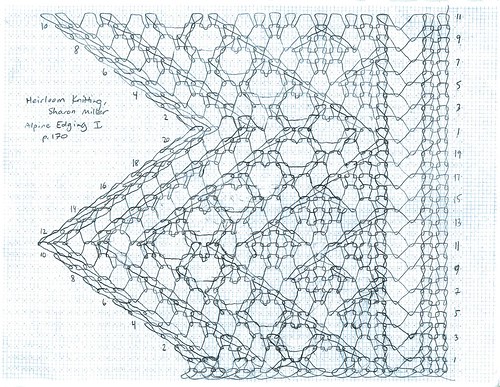
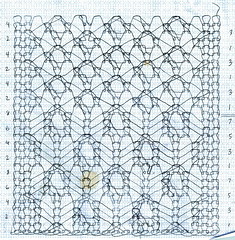
Saturday, December 12, 2009
Lace Twist-Stitch Argyle Pattern: Chart, Directions, Stitch Key
By Kind Request
One of my beloved commenters requested a stitch pattern for the "Lace Twist-Stitch 'Argyle' Pattern" (please, for the love of Pete, think of a better name). I created this pattern a while ago, and knitted it from a rough diagram whose mysterious symbols were known only to me. With this post and the accompanying PDF files (see below) I hope I've given the instructions in a shape that other people can follow.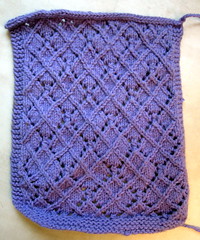 Image by fuzzyjay via Flickr
Image by fuzzyjay via Flickr
Stitch-Pattern Diagram
Close-up Fabric Photograph
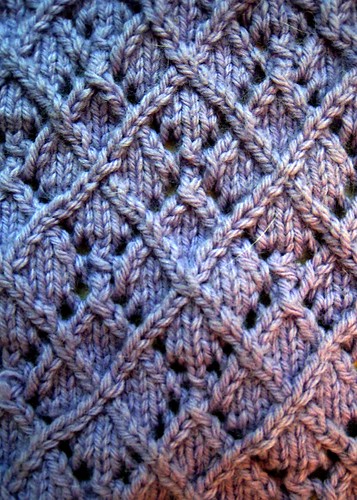
Written-out Directions
Cast on a multiple of 12 stitches plus 1. Stitch count varies. Stitch abbreviations are explained in the stitch key below.
Row 1: (And all wrong-side rows.) Purl.
Row 2:LT, *k4, YO-k1b-YO, k4, LT3, repeat from *, ending last repeat with LT.
Row 4: K1, *LT, k1, k2tog, YO, sl1-k2tog-psso, YO, ssk, k1, RT, k1, repeat from* to end of row.
Row 6: K2, *LT-dec, YO, k3, YO, RT-dec, k3, repeat from *, ending last repeat with k2.
Row 8: K1, *k2tog, YO, LT, k3, RT, YO, ssk, k1, repeat from * to end of row.
Row 10: K2tog, *YO, k2, LT, k1, RT, k2, YO, sl1-k2tog-psso, repeat from *, ending last repeat with ssk.
Row 12: K1b-YO, *k4, RT3, k4, YO-k1b-YO, repeat from *, ending last repeat with YO-k1b.
Row 14: K2tog, *YO, ssk, k1, RT, k1, LT, k1, k2tog, YO, sl1-k2tog-psso, repeat from *, ending last repeat with ssk.
Row 16: K2, *YO, RT-dec, k3, LT-dec, YO, k3, repeat from *, ending last repeat with k2.
Row 18: K2, *RT, YO, ssk, k1, k2tog, YO, LT, k3, repeat from *, ending last repeat with k2.
Row 20: K1, *RT, k2, YO, sl1-k2tog-psso, YO, k2, LT, k1, repeat from * to end of row.
Repeat rows 1-20.
Stitch Symbol Key
| Symbol | Stitch name/Stitch operation | Loops used from row below, loops resulting |
| Yarn over (YO). |
0-1
| |
| Yarn over, knit-1-back, yarn over (YO-k1b-YO). | 1-3 | |
| Knit-1-back, yarn over (k1b-YO). | 1-2 | |
| Yarn over, knit-1-back (YO-k1b). | 1-2 | |
| Knit 1 (k1). | 1-1 | |
| Knit 2 together (k2tog). | 2-1 | |
| Slip-Slip-Knit (ssk): Slip 2 as if to knit, insert left needle into front of stitches just slipped, and knit the 2 stitches together. | 2-1 | |
| Slip 1 as if to knit, knit 2-together, pass slipped stitch over the stitch just made (sl1-k2tog-psso). | 3-1 | |
| Right Twist (RT): Knit 2-together, then knit again into the first stitch on the left needle before withdrawing left needle. | 2-2 | |
| Left Twist (LT): Slip 2 as if to knit, return to left needle, Knit 1-back into 2nd stitch from end of left needle, then Knit 2-together through back loops before withdrawing left needle. | 2-2 | |
| Right 3-3 Twist (RT3): Slip 2 as if to knit, then transfer back to left needle by inserting left needle from right to left into both stitches at once and withdrawing the right needle. (Counting from the end of the left needle, the stitch order was 1-2-3, and now it's 2-1-3.) Knit 3 together, yarn over, knit 2 together before withdrawing left needle. | 3-3 | |
| Left 3-3 Twist (LT3): Slip 1 as if to knit, slip 2 as if to knit 2-together. Return the 3 stitches to the left needle, then knit 2-together through the back loops of the 2nd and 3rd stitches on the left needle, yarn over, then knit 3 together through the back loops of all three stitches before withdrawing left needle. | 3-3 | |
| Right-Twist Decrease (RT-dec): Slip 2 as if to knit, then transfer back to left needle by inserting left needle from right to left into both stitches at once and withdrawing the right needle. (Counting from the end of the left needle, the stitch order was 1-2-3, and now it's 2-1-3.) Knit 3 together, then knit 2 together before withdrawing left needle. | 3-2 | |
| Left Twist Decrease (LT-dec): Slip 1 as if to knit, slip 2 as if to knit 2-together. Return the 3 stitches to the left needle, then knit 2 together through the back loops of the 2nd and 3rd stitches on the left needle, then knit 3-together through the back loops of all three stitches before withdrawing left needle. | 3-2 |
PDF is a nice format. I like it.
If you'd like to preview the PDF file (better by far than this web page for printing), follow this link to view a preview on my Posterous blog. And if you'd like to skip a step and directly download the PDF file to look at or print, just download the PDF with diagram, instructions and stitch symbol key to "Lace and Twist-Stitch 'Argyle' pattern." (97k) If you do make anything out of this, I would love to see it. So far, I've made only swatches.Speaking of exotic charting methods
I've got a million of them. Here's one I posted before. Stop me if you've seen these:Monday, December 07, 2009
entrelac pentagram skullcap
It's meant for my little niece or little nephew. When they wear it, it will look more like a hat.
Friday, December 04, 2009
Tuesday, December 01, 2009
dayflower-detail-diagram-repeated
Because I suck at Photoshop, this is iffy, but I can work from it to do a better diagram.
Subscribe to:
Comments (Atom)
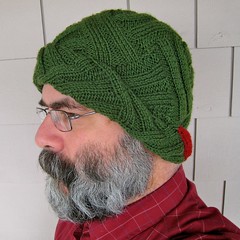
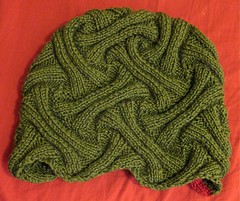
![Reblog this post [with Zemanta]](http://img.zemanta.com/reblog_e.png?x-id=55e2673d-15f2-480b-891e-cbe8133d4c83)
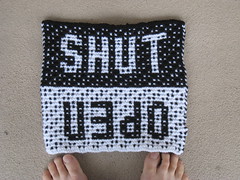
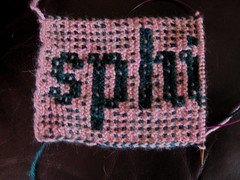
![Reblog this post [with Zemanta]](http://img.zemanta.com/reblog_e.png?x-id=867fc398-6c88-4636-b006-4c7f5ec2d940)
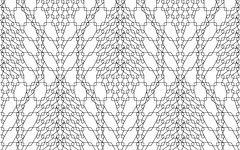



![Reblog this post [with Zemanta]](http://img.zemanta.com/reblog_e.png?x-id=3bb82b3a-3e52-4553-aca7-b76e2047fc5e)

![Reblog this post [with Zemanta]](http://img.zemanta.com/reblog_e.png?x-id=af749ed8-7bc9-44be-98f0-1b741f8a3438)


